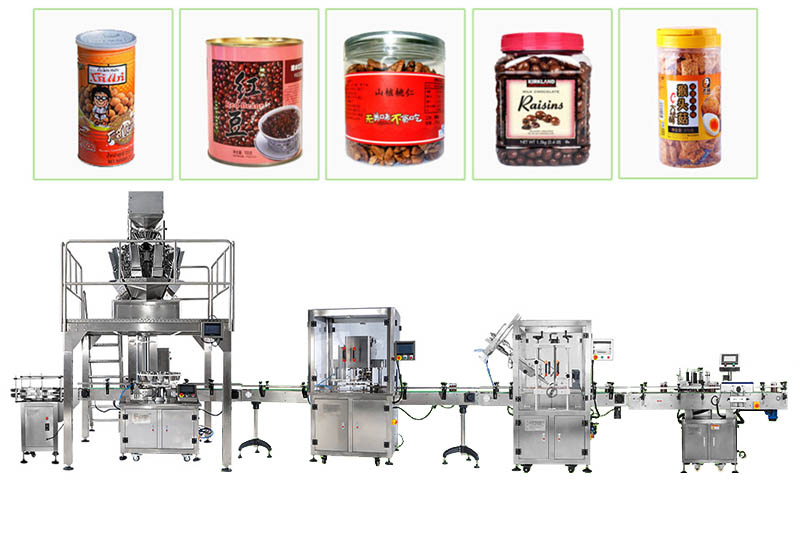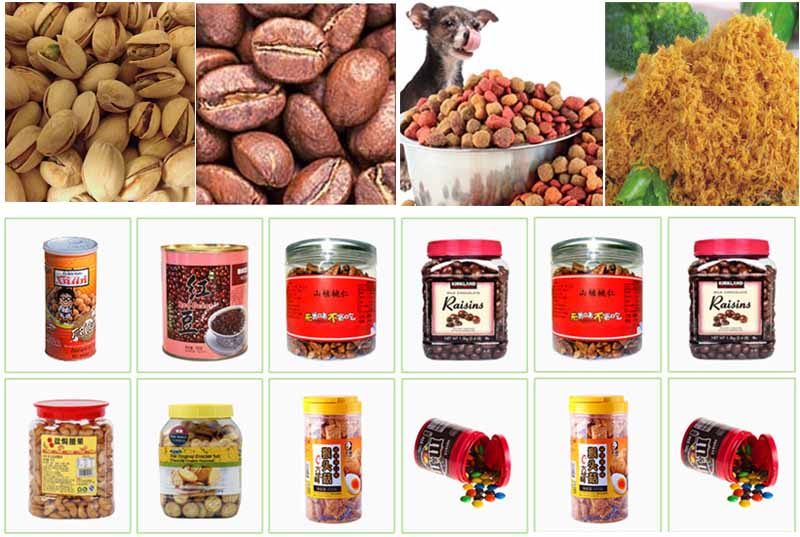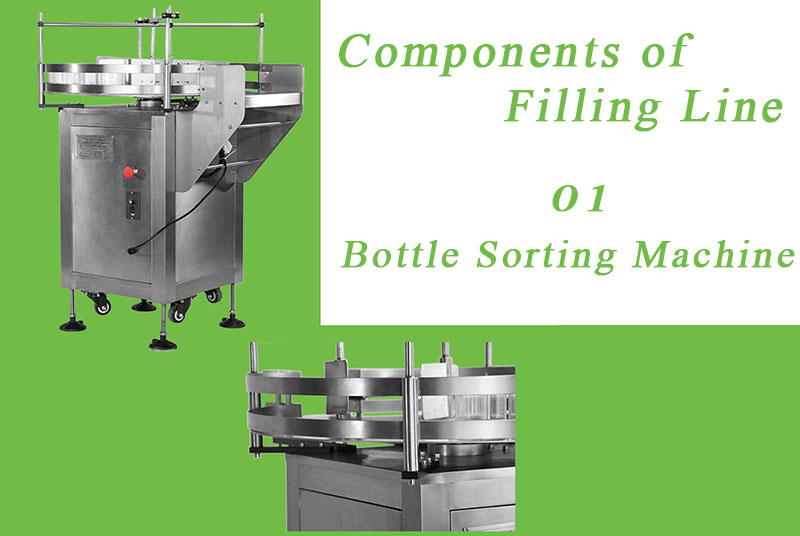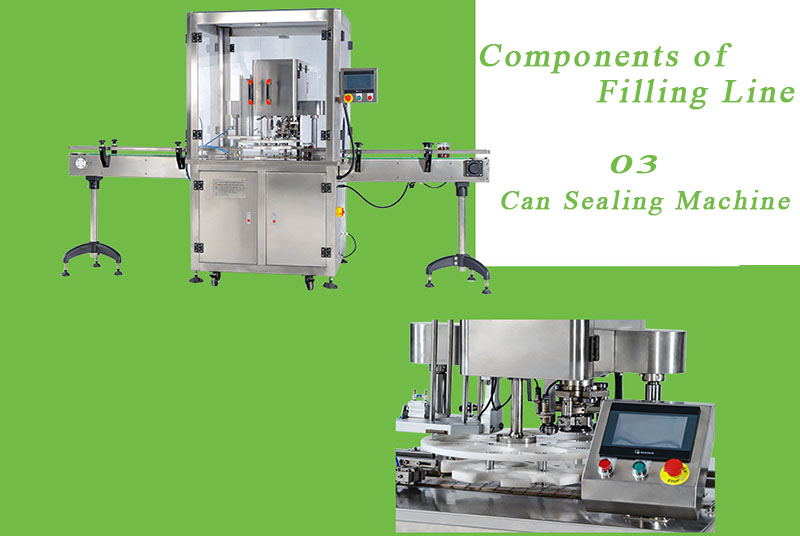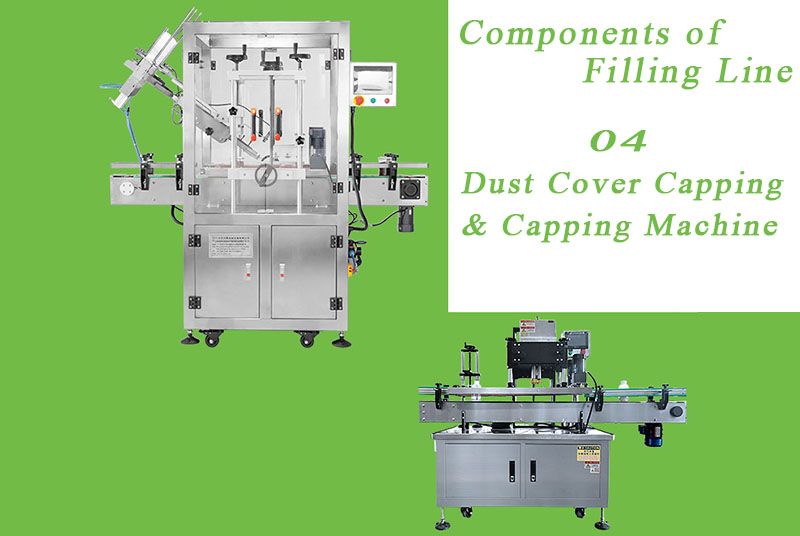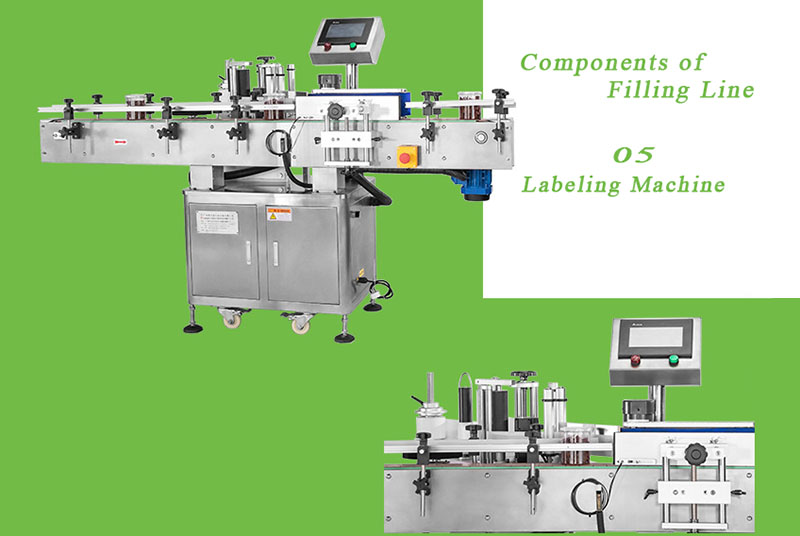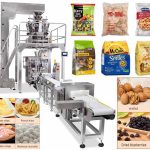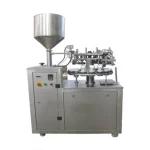Automatic Granule/ Grain / Solid Weighing and Filling Line
Description
Application:
Factory direct supply granule packaging production line is applicable for different dimension containers, suitable for bottled, canned and tinned foods. such as seafood, nuts, snacks, popcorn, puffed food and so on.
Kindly Reminder:
We have experienced team of R & D engineers who can customize packaging solutions according to your product characteristics.
Packing Exambers:
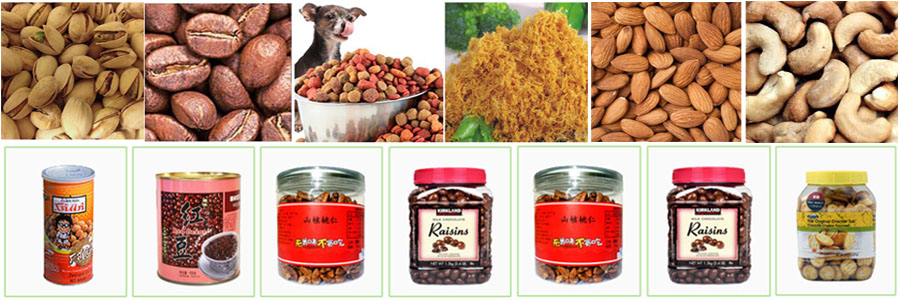
1. Full-automatic weighing-filling-sealing-sterilizing-labeling, efficient and simple to use.
2. Use famous brand electric and pneumatic components, stable and long life circle.
3. Use superior mechanical components, reduce the wear out loss.
4.PLC control and color touch screen 7″with stable and high accuracy output.
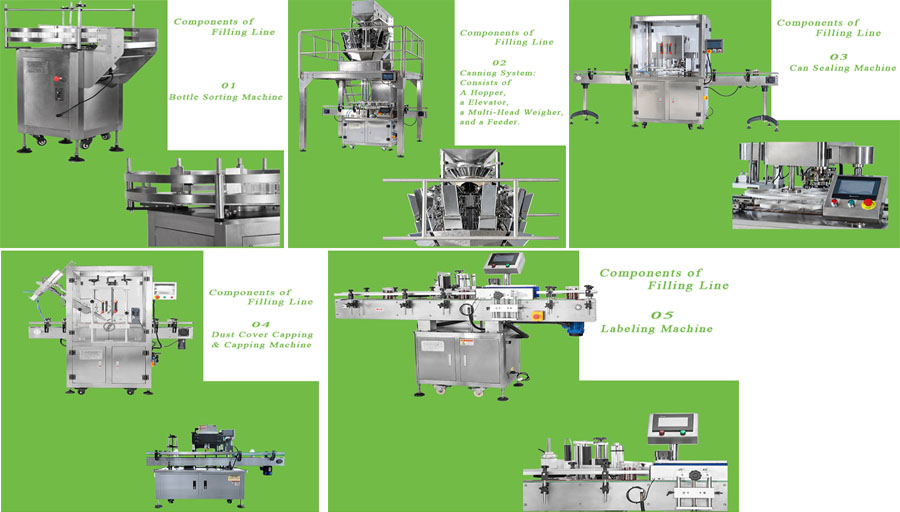
Parameter
| Name | Automatic Granule/ Grain / Solid Filling Line For Bottles Cans And Tins |
| Sealing number | 1 |
| Packing Speed | 50 cans/ min |
| Applicable can Height | 30-200mm (Adjustable) |
| Applicable can diameter | 40-150mm |
| Air sourse | 0.6-0.8MPa |
| Power | 6KW |
| Weight | 2500K |
| Size | 10000mm*3900mm*3000mm |
| Voltage | 380V/220V,50Hz |
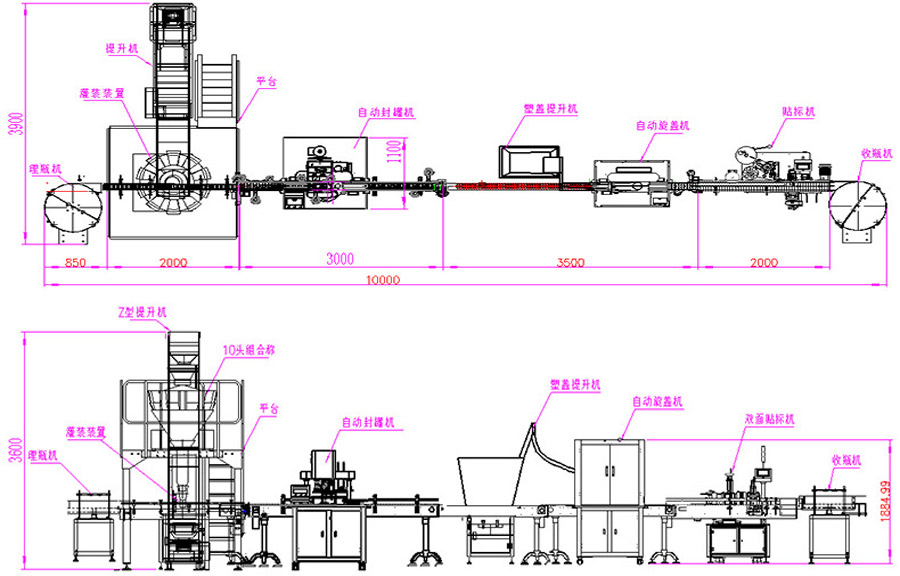
The process of weighing and filling granules or grains can be a time-consuming task. To streamline the process, an automated granule/grain weighing and filling line is the perfect solution. This type of system is designed to accurately weigh and fill granules or grains quickly and efficiently, eliminating the need for manual labor. With an automated system, you can save time and money while ensuring accuracy in your production line. The system is easy to use, reliable, and cost-effective, making it ideal for any business looking to increase efficiency in their production processes.
Benefits of Streamlining Your Processes with an Automated Granule/Grain Weighing and Filling Line
An automated granule/grain weighing and filling line is a powerful tool for streamlining processes in the industrial sector. This type of system allows for the accurate and efficient weighing, filling, and packaging of various types of granules or grains. By utilizing this technology, companies can save time and money by eliminating manual labor costs associated with traditional methods. Additionally, an automated system ensures that all products are weighed accurately and consistently to ensure quality control.
The use of an automated granule/grain weighing and filling line also provides improved safety conditions for workers due to its automated nature. The risk of human error is minimized as the machine is able to precisely weigh each item without any potential for mistakes or misjudgments from manual labor. Furthermore, it reduces the amount of time needed to complete a task since there is no need to manually weigh each item before it is packaged or shipped out. This results in faster turnaround times which can help increase productivity levels within an organization.
Overall, an automated granule/grain weighing and filling line offers numerous benefits that can help streamline processes in the industrial sector while providing improved safety conditions for workers as well as increased accuracy when measuring products before they are shipped out or packaged up for sale.
Design Considerations for Implementing an Automated Granule/Grain Weighing and Filling Line
Design considerations for implementing an automated granule/grain weighing and filling line must be carefully evaluated to ensure a successful installation. The primary components of such a system include the weighing scale, filling mechanism, conveyor system, and control system.
The weighing scale must be capable of accurately measuring the weight of each granule or grain with minimal variation. It should also have a high capacity to accommodate large batches. The filling mechanism should be able to accurately dispense the required amount of material into containers or bags with minimal spillage. It should also be able to handle different sizes and shapes of containers or bags without difficulty.
The conveyor system is responsible for transporting the materials from one station to another in an efficient manner. It should be designed with safety features such as guards and sensors that detect foreign objects in order to prevent accidents and damage to equipment. The control system is responsible for controlling all aspects of the process including speed, accuracy, timing, etc., so it must be reliable and easy-to-use.
Finally, all components must meet applicable safety standards in order to ensure safe operation during production runs. Additionally, careful consideration should also be given when selecting materials for use in contact with food products as they may affect product quality or pose health risks if not chosen correctly.
Cost-Benefit Analysis of Installing an Automated Granule/Grain Weighing and Filling Line
A cost-benefit analysis of installing an automated granule/grain weighing and filling line can be a valuable tool for businesses looking to increase efficiency and reduce costs. The automated line can weigh, fill, package, and label products with accuracy and speed. It also eliminates the need for manual labor in the process.
The cost of installation includes hardware such as scales, conveyors, and packaging equipment; software for programming; personnel training; maintenance costs; energy consumption; facility upgrades; product testing; etc. The benefits include increased production capacity, improved product quality control, reduced labor costs, improved safety standards, faster turnaround times on orders, lower energy consumption rates due to automation technology, improved customer satisfaction due to better packaging and labeling accuracy.
The cost-benefit analysis should take into account the expected return on investment (ROI) over time. This will help determine if the installation is a worthwhile investment or not. Additionally, it is important to consider any potential risks associated with the installation such as breakdowns or malfunctions that could lead to costly repairs or replacements down the road.
Overall, an automated granule/grain weighing and filling line can provide significant benefits in terms of increased efficiency and reduced costs over time if installed correctly with proper maintenance procedures in place. A thorough cost-benefit analysis should be conducted before making any decisions about investing in this type of system.
Optimizing Efficiency with Automation: A Guide to Setting Up a Granule/Grain Weighing and Filling Line
Setting up a granule/grain weighing and filling line is an important step in optimizing efficiency with automation. This guide provides the necessary information to help ensure that the process is successful.
The first step is to select a suitable location for the line. It should be well-ventilated, have adequate space for all components, and provide easy access to electrical outlets and other utilities. The next step is to assemble the components of the line, including scales, conveyors, filling machines, and any other necessary equipment. Once assembled, it’s important to test each component of the system before beginning production.
The next step is programming each component of the system with appropriate settings such as speed control parameters or fill rate adjustments. This will ensure that each component works together properly and produces consistent results throughout production runs. Additionally, it’s important to set up quality control measures such as weight checks or product inspections at regular intervals throughout production runs in order to maintain product quality standards.
Finally, it’s essential that personnel are trained on how to use and maintain all components of the system correctly in order for it to operate efficiently over time without interruption or downtime due to mechanical failure or operator error. Regular maintenance should also be performed on all components in order for them remain functioning properly over time and reduce costly repairs or replacements down the road.
By following this guide when setting up a granule/grain weighing and filling line can help optimize efficiency with automation by ensuring that each component functions correctly while producing consistent results throughout production runs while also reducing downtime due costly repairs or replacements down the road through regular maintenance procedures being followed by personnel who are trained on how use them correctly over time
Troubleshooting Common Issues in an Automated Granule/Grain Weighing and Filling Line
Troubleshooting common issues in an automated granule/grain weighing and filling line requires a comprehensive understanding of the system’s components and processes. The most common issues are related to incorrect calibration, incorrect settings, mechanical malfunctions, or electrical faults.
Incorrect calibration can cause the system to overfill or underfill containers. To troubleshoot this issue, technicians must check the calibration of each component in the system. This includes checking for correct settings on sensors, actuators, and other components that control the flow rate of material into containers. If any discrepancies are found, technicians must adjust these settings accordingly to ensure accurate filling levels.
Incorrect settings can also lead to problems with the system’s performance. To troubleshoot this issue, technicians must review all user-defined parameters such as container size and weight limits as well as any additional variables that may affect accuracy or throughput rates. Once these parameters have been verified against manufacturer specifications they should be adjusted accordingly if necessary to ensure optimal performance from the system.
Mechanical malfunctions can also cause problems with an automated granule/grain weighing and filling line. To troubleshoot this issue technicians must inspect all moving parts for signs of wear or damage such as broken belts or worn bearings which could impede proper operation of machinery components leading to inaccurate results or decreased throughput rates. Any damaged parts should be replaced immediately before further testing is conducted on the system’s accuracy and performance levels .
Finally electrical faults can cause problems with an automated granule/grain weighing and filling line due to improper wiring connections between various components in the system leading to inaccurate readings from sensors or incorrect activation signals being sent by actuators causing improper operation of machinery parts resulting in inaccurate results or decreased throughput rates . To troubleshoot this issue technicians must inspect all wiring connections for signs of corrosion , loose connections , damaged wires , etc . Any faulty wiring should be repaired immediately before further testing is conducted on accuracy and performance levels .
Conclusion
The automated granule/grain weighing and filling line offers a streamlined process that helps businesses increase efficiency and reduce costs. This system can be tailored to the specific needs of any business, making it a great choice for those looking to streamline their processes. With its advanced technology, this system can provide accurate results quickly and efficiently, allowing businesses to maximize their output while minimizing waste. By investing in an automated granule/grain weighing and filling line, businesses can save time, money, and resources while ensuring quality products every time.


